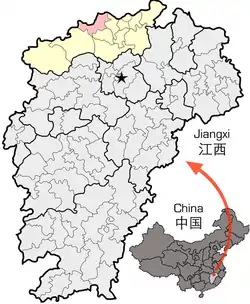Ruichang
Ruichang (Chinese: 瑞昌; pinyin: Ruìchāng) is a county-level city under the jurisdiction of Jiujiang, in the north of Jiangxi province, along the Yangtze River, bordering Hubei province to the north.
Ruichang
瑞昌市 Juichang | |
|---|---|
 Location of Ruichang (red) in Jiujiang City (yellow) and Jiangxi | |
| Coordinates: 29°40′34″N 115°40′52″E | |
| Country | People's Republic of China |
| Province | Jiangxi |
| Prefecture-level city | Jiujiang |
| Area | |
| • Total | 1,423.11 km2 (549.47 sq mi) |
| Population (2018) | |
| • Total | 462,700 |
| • Density | 330/km2 (840/sq mi) |
| Postal Code | 332200 |
Ruichang suffered deaths and extensive damage from the 2005 Ruichang earthquake.
Administrative divisions
Ruichang City is divided to 2 subdistricts, 8 towns and 9 townships.[1]
- 2 subdistricts
- Pencheng (湓城街道)
- Guilin (桂林街道)
- 8 towns
|
|
- 9 townships
|
|
Transportation
Ruichang is served by the Wuhan–Jiujiang Railway.
Climate
| Climate data for Ruichang (1981−2010) | |||||||||||||
|---|---|---|---|---|---|---|---|---|---|---|---|---|---|
| Month | Jan | Feb | Mar | Apr | May | Jun | Jul | Aug | Sep | Oct | Nov | Dec | Year |
| Record high °C (°F) | 21.8 (71.2) |
28.0 (82.4) |
33.1 (91.6) |
34.4 (93.9) |
36.9 (98.4) |
37.7 (99.9) |
40.8 (105.4) |
40.1 (104.2) |
38.3 (100.9) |
35.3 (95.5) |
30.1 (86.2) |
24.0 (75.2) |
40.8 (105.4) |
| Average high °C (°F) | 8.3 (46.9) |
10.7 (51.3) |
15.1 (59.2) |
21.7 (71.1) |
27.0 (80.6) |
29.8 (85.6) |
33.5 (92.3) |
32.6 (90.7) |
28.4 (83.1) |
23.3 (73.9) |
17.1 (62.8) |
11.2 (52.2) |
21.6 (70.8) |
| Daily mean °C (°F) | 4.4 (39.9) |
6.7 (44.1) |
10.7 (51.3) |
17.1 (62.8) |
22.3 (72.1) |
25.6 (78.1) |
29.1 (84.4) |
28.2 (82.8) |
24.0 (75.2) |
18.4 (65.1) |
12.2 (54.0) |
6.5 (43.7) |
17.1 (62.8) |
| Average low °C (°F) | 1.6 (34.9) |
3.8 (38.8) |
7.4 (45.3) |
13.2 (55.8) |
18.3 (64.9) |
22.2 (72.0) |
25.5 (77.9) |
24.9 (76.8) |
20.7 (69.3) |
14.8 (58.6) |
8.6 (47.5) |
3.1 (37.6) |
13.7 (56.6) |
| Record low °C (°F) | −6.4 (20.5) |
−6.2 (20.8) |
−3.4 (25.9) |
1.2 (34.2) |
9.3 (48.7) |
14.0 (57.2) |
17.8 (64.0) |
17.3 (63.1) |
12.0 (53.6) |
2.5 (36.5) |
−2.5 (27.5) |
−10.3 (13.5) |
−10.3 (13.5) |
| Average precipitation mm (inches) | 68.7 (2.70) |
88.7 (3.49) |
139.6 (5.50) |
188.8 (7.43) |
192.8 (7.59) |
222.6 (8.76) |
171.8 (6.76) |
135.9 (5.35) |
108.5 (4.27) |
77.6 (3.06) |
71.0 (2.80) |
40.1 (1.58) |
1,506.1 (59.29) |
| Average relative humidity (%) | 79 | 79 | 79 | 78 | 77 | 80 | 77 | 79 | 79 | 76 | 77 | 75 | 78 |
| Source: China Meteorological Data Service Center[2] | |||||||||||||
References
- "南京市-行政区划网 www.xzqh.org" (in Chinese). XZQH. Retrieved 2012-05-24.
- 中国地面气候标准值月值(1981-2010) (in Chinese). China Meteorological Data Service Center. Retrieved 10 October 2019.
This article is issued from Wikipedia. The text is licensed under Creative Commons - Attribution - Sharealike. Additional terms may apply for the media files.